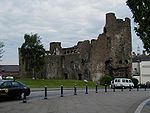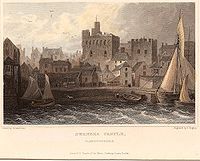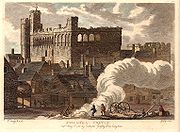
Swansea Castle
Encyclopedia

Henry de Beaumont, 1st Earl of Warwick
Henry de Beaumont, 1st Earl of Warwick was a Norman nobleman. Henry was the younger son of Roger de Beaumont and Adeline of Meulan, daughter of Waleran I, Count of Meulan. He was given by his father the modest lordship of Le Neubourg, in central Normandy...
in 1106 as the caput
Caput
The Latin word caput, meaning literally "head" and by metonymy "top", has been borrowed in a variety of English words, including capital, captain, and decapitate...
of the lordship of Gower, in Swansea
Swansea
Swansea is a coastal city and county in Wales. Swansea is in the historic county boundaries of Glamorgan. Situated on the sandy South West Wales coast, the county area includes the Gower Peninsula and the Lliw uplands...
, Wales
Wales
Wales is a country that is part of the United Kingdom and the island of Great Britain, bordered by England to its east and the Atlantic Ocean and Irish Sea to its west. It has a population of three million, and a total area of 20,779 km²...
.
History
The original castleCastle
A castle is a type of fortified structure built in Europe and the Middle East during the Middle Ages by European nobility. Scholars debate the scope of the word castle, but usually consider it to be the private fortified residence of a lord or noble...
seems to have been a sub-rectangular/oval enclosure overlooking the River Tawe
River Tawe
The River Tawe is a river in South Wales. It flows in a principally south-westerly direction for some from its source below Moel Feity in the Old Red Sandstone hills of the western Brecon Beacons to the Bristol Channel at Swansea. Its main tributaries are the right bank Upper and Lower Clydach...
on the east, surrounded on the north, west and south sides by a larger sub-rectangular outer bailey. The inner bailey probably contained a motte but the other view is that it was a ring work. The new castle was attacked by the Welsh
Wales
Wales is a country that is part of the United Kingdom and the island of Great Britain, bordered by England to its east and the Atlantic Ocean and Irish Sea to its west. It has a population of three million, and a total area of 20,779 km²...
in 1116 but the inner castle held.

Llywelyn the Great
Llywelyn the Great , full name Llywelyn ab Iorwerth, was a Prince of Gwynedd in north Wales and eventually de facto ruler over most of Wales...
and Henry III of England
Henry III of England
Henry III was the son and successor of John as King of England, reigning for 56 years from 1216 until his death. His contemporaries knew him as Henry of Winchester. He was the first child king in England since the reign of Æthelred the Unready...
. Immediately after this the inner castle was probably walled in stone with at least one tower.

Garderobe
The term garderobe describes a place where clothes and other items are stored, and also a medieval toilet. In European public places, a garderobe denotes the cloakroom, wardrobe, alcove or an armoire. In Danish, Dutch, German and Spanish garderobe can mean a cloakroom. In Latvian it means checkroom...
tower) is capped with an elegant series of arcades
Arcade (architecture)
An arcade is a succession of arches, each counterthrusting the next, supported by columns or piers or a covered walk enclosed by a line of such arches on one or both sides. In warmer or wet climates, exterior arcades provide shelter for pedestrians....
at the wall-head, which are similar to structures at the Bishop of Saint David's palaces at Lamphey
Lamphey
Lamphey is a village near the south coast of Pembrokeshire, Wales, two miles east of Pembroke.-History:Lamphey is a small village with an estimated population of 250 to 300 people, being located a short distance from the historic town of Pembroke, the birth place of Henry VII, father of Henry...
and St David's
St David's
St Davids , is a city and community in Pembrokeshire, Wales. Lying on the River Alun on St David's Peninsula, it is Britain's smallest city in terms of both size and population, the final resting place of Saint David, the country's patron saint, and the de facto ecclesiastical capital of...
.
By then the castle had lost its military importance. It is not known whether it fell to allies of Owain Glyndŵr
Owain Glyndwr
Owain Glyndŵr , or Owain Glyn Dŵr, anglicised by William Shakespeare as Owen Glendower , was a Welsh ruler and the last native Welshman to hold the title Prince of Wales...
early in the 15th century.
In the 18th and 19th centuries parts of the castle were variously used as a market, a town hall, a drill hall and a prison.

